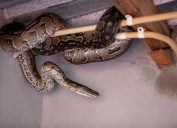The No. 1 Way to Keep Snakes From Getting in Through Your Shower
You've heard they can get up your toilet, but your shower's not safe either, experts say.
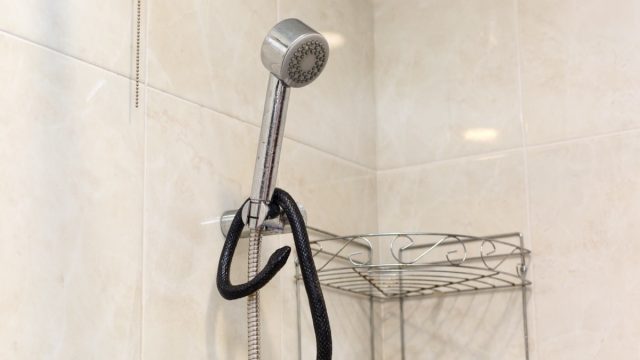
You've no doubt heard the horror stories. Someone lifts a toilet lid, and boom, there's a snake. But snakes also like to get into your house through another, almost scarier part of your bathroom: the shower. Yes, it's a rare occurrence, but it happens. Considering that snake bites are seriously painful—sometimes downright dangerous—running into one in your home is less than ideal. Read on to hear straight from the experts about how to stop snakes from getting in through your shower.
READ THIS NEXT: The No. 1 Sign There's a Snake Behind Your Water Heater.
This is why snakes love your bathroom.
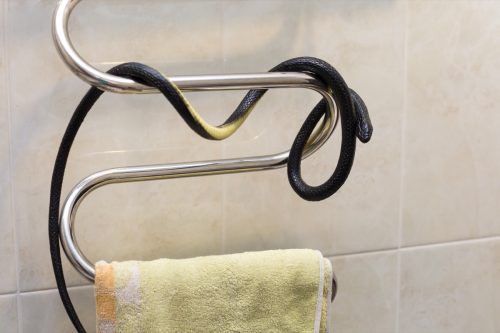
Snakes love hiding out in cool, dark places, so it's only natural they'd seek out a bathroom. (They also like dry spaces, but chances are, any household full of people who regularly shower has a bathroom with at least some moisture all around.) Snakes can also traverse through pipes and drains, which, of course, your bathroom has no shortage of.
And once they're in a room, they look for places to hide. When it comes to bathrooms, it's important to declutter, Jennifer Mecham, a snake expert and writer with Reptiles Blog, previously told Best Life. "This includes items like piles of clothing, towels, bath mats, and other similar items."
For more snake advice delivered straight to your inbox, sign up for our daily newsletter.
And this is why they enter your house through the shower.
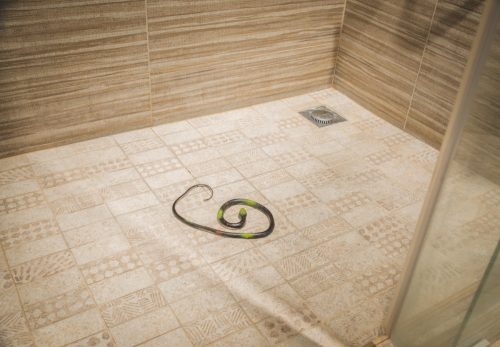
Snakes notoriously love the traditionally neglected spaces of your home—ground-level areas like your basement, garage, or crawl space—so it's natural to think they get into your shower from the pipes below. But no, they come from above.
"The majority of snakes that enter toilets or shower drains initially emerge from the ventilation lines rather than the water pipes," Maria Ivanova, the founder of Toronto-based home cleaning company Master Maid tells Best Life. "Typically, ventilation pipes are found on roofs… A snake can readily enter the drainpipe, the shower, or the toilet after gaining entrance to the ventilation pipe."
Of course, snakes don't have limbs or opposable thumbs, but they're still excellent climbers and can scale anything from lattices to drainage pipes to adjacent trees.
Here's how to stop snakes from getting in through the shower.

To prevent snakes from getting into your shower, the first thing you should do is trim any tree branches near your roof, Rosenbloom says. "This will not only limit snakes from getting up there, but other pests that may be getting in your pipes or attic as well," he says.
You can also take preventative measures. Rosenbloom suggests getting a multiflap—basically, a device "that fits over your toilet pipe and lets water and waste out but will not allow anything as big as a snake to come in through the drain," as he describes it. (There are several good options on the market, but the proprietary versions from the aptly named British company Multi Flap are considered top-of-the-line.)
Your other option is to put some elbow grease into it with some good old-fashioned handiwork. "Get some wire mesh and a vent hood and top off your ventilation pipes," Rosenbloom says. "This will stop any animal from getting inside these pipes. And if they can't get in the exhaust pipes, they have no way to get into your shower drain pipe or toilet. Unless, of course, they come from the sewer."
These are clues a snake may be present.
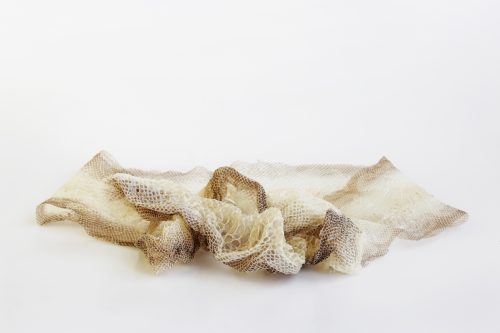
The most common way to determine if a snake has been in almost any room is the presence of skin, as snakes shed their skin naturally once every month to three months. Droppings are another tell-tale sign.
"Usually, the skins are a bit easier to spot in dusty areas… because they're a paper-thin exoskeleton in snake form," Sholom Rosenbloom, the owner of Baltimore-based Rosenbloom Pest Control, previously told Best Life. "But these are both bodily functions that snakes can't help, so they're the clearest indicator that a pest is hiding."
And here's what to do if you see a snake.
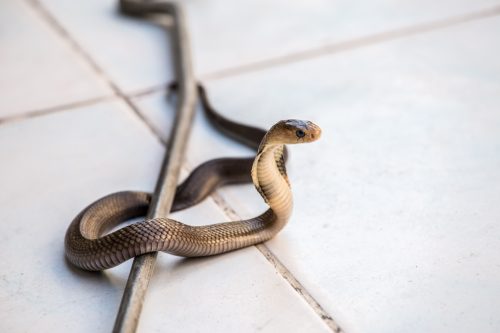
If you see a snake or believe one has gotten in through your shower, the smartest thing to do is enlist a professional. "Consider calling a pest control company for snake removal, snake prevention recommendations, and possibly other exterminating services like rodent control that could be contributing to the issue," Rosenbloom previously advised.
